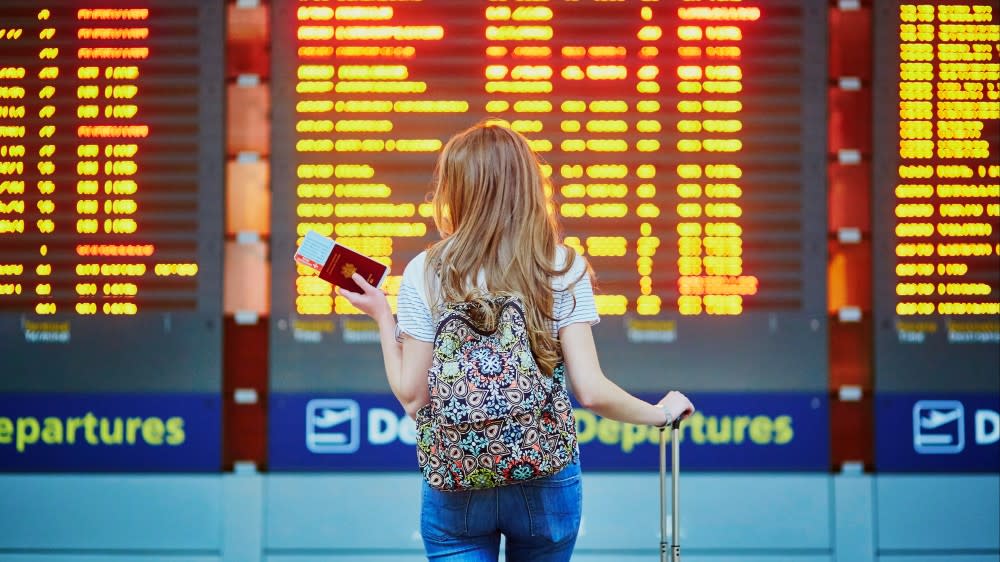As an international student planning to study in the US, you may have come across different types of student visas in your research. The most common types of student visas are a F-1 visa and a J-1 visa. F-1 and J-1 visas are necessary for different types of programs and have different conditions, requirements, and benefits. This is why it is important to understand each type of US student visa in detail before you apply to study in the US.
This detailed guide covers everything you need to know about the Exchange Visitor (J) non-immigrant visa (also known as the J-1 student visa) including J-1 visa basics, eligibility to work as a J-1 student, the difference between the F-1 and J-1 visas, J-1 visa student requirements, how to submit your J-1 visa application, and more!
What Is a J-1 Student Visa?
The J-1 visa, also known as the Exchange Visitor Visa or J student visa, is for anyone outside of the US who wishes to take part in study- and work-related exchange programs approved by the Department of State Bureau of Educational and Cultural Affairs. Typically, a J-1 student visa holder is sponsored by an educational or nonprofit institution.
The J-1 visa has 15 categories of eligible roles and/or program types:
Au Pair
Camp Counselor
College and University Student
Secondary School Student
Government Visitor
International Visitor
Physician
Professor
Research Scholar
Short-Term Scholar
Specialist
Summer Work Travel
Teacher
Trainee
Intern
When you apply for a J-1 student visa under the College and University Student Program category, you can study at a college or university in the US and remain in the country for the duration of your course or degree program.
The duration of your stay in the US on a J-1 student visa depends on the program you choose to pursue. For example, if your J-1 visa is for a Camp Counselor program, you likely will have a short stay in the US (e.g., four months, over the summer), whereas Au Pair and Research Scholar programs could require J-1 visas that are valid for several years in the US.
J-1 visa holders are required to return to their home country after graduation and live there for at least two years. You will only be allowed to return to the US after fulfilling this requirement. In the case of emergency or special circumstances related to returning to your home country, this requirement may be waived.
Can You Work in the US with a J-1 Visa?
Yes, you can! J-1 students are permitted to work while studying, as long as they obtain work authorization. There are certain restrictions, such as only working part time on campus for a maximum of 20 hours per week. Students are permitted to work full time during academic breaks.
What Is the Difference Between a J-1 and F-1 Student Visa?
While J-1 student visas and F-1 student visas seem similar, there are distinct differences you should be aware of when choosing the visa you want to apply for:
Point of contact—J-1 students are required to coordinate with a Responsible Officer from their program sponsor. Responsible Officers are required to check up on the health, safety, and welfare of J-1 visa students and make sure they are complying with all visa requirements. F-1 students have access to a Designated School Official (DSO) at their college or university, and DSOs are responsible for helping the student with all visa requirements and regulations throughout their time in the US.
Certificates of eligibility—When applying for a J-1 student visa, students are required to submit Form DS-2019. This form outlines program details and other important information, including a cost breakdown, start and end dates for your program, and options for financial support. F-1 students are required to submit an I-20 form, which contains the same information.
Post-graduation work and training—J-1 students are eligible for Academic Training (AT) in a field related to their program for up to 18 months after graduation. J-1 students who have earned a PhD can request an additional 18 months of AT in their related field. With a F-1 student visa, students can apply to work for up to 12 months in the US in a related field via Optional Practical Training (OPT) after graduation. For STEM degrees, F-1 students can request two additional years of work in their field.
Working restrictions—While J-1 visa students can only work on campus, F-1 students can work off campus after completing one academic year of study. Additionally, the dependents (spouses and children) of J-1 visa students are permitted to work and study in the US full time. The dependents of F-1 students cannot work, but can enroll in part-time study.
Funding source—J-1 students have programs funded by an accredited educational or nonprofit institution. F-1 students can be funded by friends and family, or even their own financial contributions.
Home residency requirements—J-1 visa students are required to return to their home countries within 30 days after their program’s end date (if they do not have any extensions) and live there for two years before returning to the US. F-1 students do not have this requirement attached to their visa conditions, but they must depart the United States within 60 days after their program has ended if they do not have any extensions.
Refer to the Exchange Visitor Program to learn more about the differences between F-1 vs J-1 visas and Shorelight’s F-1 visa guide for more information.
What Are the J-1 Visa Program Requirements?
Make sure you meet the following J-1 visa student requirements when submitting your application:
Maintain your funding source—At least 50% of the funding for your program must be provided by an accredited sponsor that is not a personal friend or family member.
Meet English language proficiency requirements—You must meet the required English language proficiency score of the university or college where you hope to enroll.
Maintain valid insurance—Both you and any dependents must have medical insurance which meets the minimum standards outlined by your host university.
Follow through with pre-arrival information and attend orientation—Your sponsor is required to provide you and any dependents with information about the selected program and conduct an orientation with information about the region where you will study.
Adhere to J-1 visa rules—You and your sponsor must ensure that you are following all J-1 visa requirements and are actively maintaining your status as a J-1 student. Your sponsor must also provide you with an emergency 24-hour contact.
Meet home residency requirements—Upon completion of your program, you must return to your home country and live there for at least two years.
Have a valid passport—You and any dependents must ensure that your passports are valid for US travel for at least six months ahead of your program completion date.
Maintain full-time enrollment during the academic year—While you can work full time during academic break periods, you must ensure that you are enrolled in full-time study when the academic year is in session.
Follow work restrictions—If you want to work while you study, ensure that you only work on campus part time for a maximum of 20 hours per week. You can work full time during academic breaks. However, working off campus is not permitted if you do not have authorization from your sponsor and university.
Make sure your address is updated—If you change your residence, you are required to update both your sponsor and your university of the address change within 10 days.
How Do You Submit a J-1 Visa Application?
To submit your application, ensure that you have read J-1 visa requirements and prepared all required documents:
DS-2019 form, Certificate of Eligibility for Exchange Visitor Status
DS-7002 form, Training/Internship Placement Plan (only necessary for exchange visitor trainees or intern visa applicants)
DS-160 form, Online Nonimmigrant Visa Electronic Application
Valid passport
One 2x2 photograph
You may also be asked to provide additional documents for the review process, so pay close attention to the instructions from the US embassy or consulate. After you submit your application, remember to get a payment receipt to present at your visa interview.
If you have decided to apply for a J-1 student visa, here are the steps you will need to follow:
1. Decide on a Sponsor
As one of the main conditions of a J-1 student visa, your program needs to be sponsored by a non-personal source. You will need to locate a sponsor willing to fund your program. Keep in mind that the sponsor must be accredited by the United States Department of State. You can view a full list of their designated sponsor organizations here.
2. Submit Your DS-2019 Form
After applying to a sponsor and getting accepted to the program, you will need to submit the DS-2019 form, as this is your Certificate of Eligibility to apply for J-1 status. The form is issued by your designated sponsor and if you have any dependents, you will receive a different version of the DS-2019 form — so remember to make sure you have received the correct form.
3. Pay the Required Fees
Aside from your program fee, there are multiple fees you may need to pay during the application process. One is the Student and Exchange Visitor Information System (SEVIS) I-901 fee and it must be paid to the Department of Homeland Security (DHS). Depending on the program or your sponsor, this fee may or may not be a part of your program fee, so be sure to check with your Responsibility Officer.
The other fees include a nonimmigrant visa application processing fee and a visa issuance fee; both can be paid at the US embassy in your home country. You do not need to pay these fees if your program is sponsored by the Department of State, US Agency for International Development (USAID), or a US government-funded educational and cultural exchange program.
4. Schedule a Visa Interview
For your application to be accepted, you will be interviewed by a consular officer at your local US Embassy or Consulate. You should schedule your appointment as early as you can, as waiting times can vary depending on your country. If you have dependents, you can also schedule an appointment for them to accompany you for your interview.
5. Attend Your Visa Interview
The consular officer will interview you with the goal of understanding your intentions behind traveling to the US. You can expect questions like:
Why did you choose your area of study?
Do you plan to pursue further education?
What are your parents’ professions?
Who pays for your education?
Do you plan to return to your job after your exchange program?
What are your employment goals a few years from now?
Why do you want to be part of an exchange program?
When you are attending the interview, remember to bring:
A valid passport
A copy of the photo you will use for your visa
DS-160 and I-901 SEVIS payment confirmation receipts
I-20 form
Diploma, school transcripts, and official standardized test scores
Bank statements you used to complete your college application
How Can Shorelight Support You?
Shorelight provides a variety of international student resources and visa services to help you understand everything you need to know about how to study in the US, researching your university options, degree options, preparing for your visa interviews, and more.
Are you ready to take the first step toward studying in the US? Speak to a Shorelight advisor today >>

